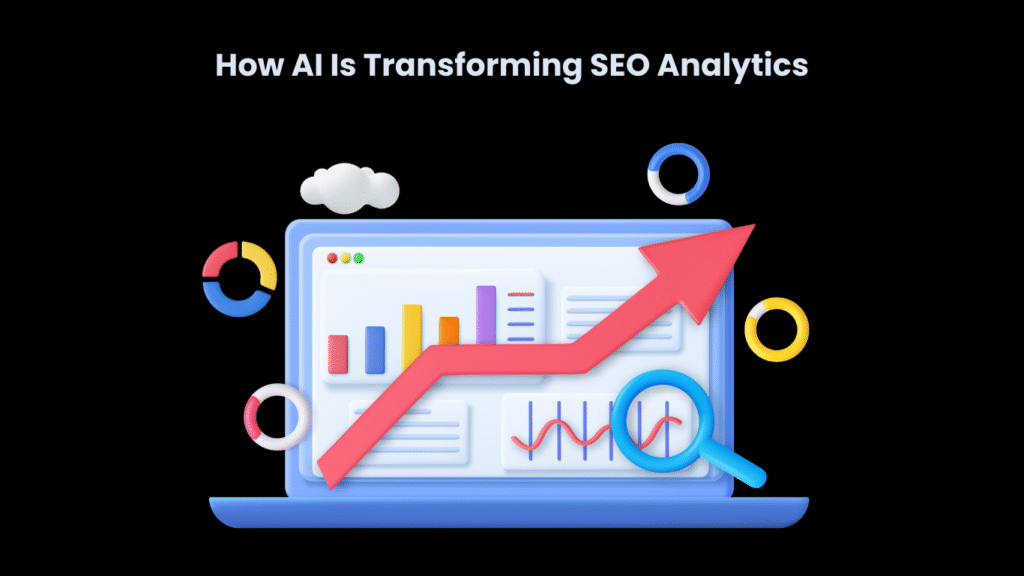Online search has long been integrated into our daily lives. Googling something has been habitual for years. And this made search engine optimization one of the most powerful tools for establishing trust and growing businesses.
Today, it remains important. But it’s changing. Of course, SEO has never been static and has always changed. That’s true. However, today, we’re observing one of its biggest shifts in years. And it’s all because of artificial intelligence. AI is reshaping pretty much everything we know about SEO, from ranking mechanisms and user behavior to the way we track results and refine our strategies. Partnering with the best SEO outsourcing company can help businesses leverage AI-driven insights to optimize campaigns, improve rankings, and maximize ROI efficiently.
In this article, we’ll talk about the major changes it poses for optimization and the new era of AI SEO analytics.
AI Search Visibility: The New Dimension of Optimization
Speaking about the role of AI in SEO in today’s landscape, we can’t ignore the massive shift toward alternative search methods. Google SERPs remained the primary tool for finding information on the web for years. But AI is opening a whole new dimension in online search.
More and more people are switching from Google to AI-powered tools like ChatGPT. And even those who stay in SERPs now don’t have to dig through plenty of pages to find the answers they need—AI Overviews do it for them. And these direct, generated answers appear on top of other SERP results, which means that ranking #1 is no longer the ultimate goal of SEO.
Today, real visibility spans both ranking in traditional SERPs and getting featured in results generated by ChatGPT, AI Overviews, and similar,an area where expert Generative Engine Optimization (GEO) consulting and platforms like the Best GEO Platform can help businesses optimize for AI-driven discovery and conversational search. In terms of SEO analysis, this means that businesses and marketers need to rely on a new category of tools. They use ChatGPT visibility tracking tools to analyze how often their content surfaces in generated results, assess the sentiment of mentions, and discover how to rank in AI search more effectively.
Given that the popularity of this type of search keeps growing, we believe that tracking AI search visibility will become an integral part of SEO analytics from now on. It will give us valuable insights into how to make our content visible for generative tools, and will let us stay competitive through these changes.
AI-Driven SEO Keyword Research and Content Analysis
Another big shift driven by artificial intelligence is a different way of ranking results. Google determines positions in SERPs through keyword-matching. Simply put, it connects the user’s query to content that targets a particular keyword and provides relevant information.
ChatGPT visibility is determined differently. AI looks beyond keywords. It leverages NLP to grasp the context behind each request. The algorithm analyzes the semantic meaning of the query, connected topics, and the user’s unique preferences and interests. This is done to identify the search intent and deliver personalized answers. So, yes, keywords are no longer the center of search engine optimization. Now, we need to tap into the intents our audience has and match them in our content.
So, how does this shift transform organic SEO analytics? Basically, it requires us to rely on artificial intelligence in keyword research. Advanced keyword research tools built on an AI basis can process huge datasets from multiple sources. They don’t just look into search engines. Instead, they also draw data from forums, social media, etc. Such a deep analysis enables AI to look beyond keywords and uncover topical patterns and correlations, as well as user intent behind each query.
AI-based tools can provide you with smart keyword suggestions, automatically grouped into clusters by topical relevance and intent. This gives you data you can instantly implement in your strategy. Also, speaking about AI search visibility and keyword targeting, we can’t avoid mentioning one of the biggest changes in terms of which queries should be used. Since ChatGPT is a conversational model that provides answers in a dialogue manner, it’s important that we target long, conversation-like keywords. In particular, question-based keywords can greatly increase your chances of being featured in generative results.
It’s also possible to use AI-powered SEO analytics beyond content discovery. It can give you insights into content gaps as well. AI models can help analyze your existing copy and organize it into clusters. Based on this, algorithms can suggest topical gaps that you can cover for maximum outreach. It can also handle automatic semantic analysis for you. Using the knowledge of how search engines understand topics and user intents, artificial intelligence can provide informed suggestions on how you can expand existing articles with valuable data. This will help you increase the depth of your copy and make it more relevant to the audience.
Lastly, SEO software enhanced with artificial intelligence can also help you uncover topical gaps through competitor benchmarking. It will let you automatically crawl and cluster competitor content. This will tell you which topics your top-performing competitors are covering.
Informed Forecasts and Strategy Adjustment in Real Time
Finally, speaking about how SEO analysis has changed with the introduction of AI, we can’t ignore the power of predictive analytics. Artificial intelligence uses machine learning and statistical modeling as tools to detect patterns. This way, it can make informed forecasts. And this can give you a significant advantage in SEO.
There are three ways to use this opportunity in your strategy:
Predicting Rankings and Trends to Stay Ahead
When you integrate AI in SEO, it unlocks the opportunity to create statistical predictive models. What does this mean? In simple terms, artificial intelligence brings together historical data about algorithm updates, past ranking performance, and user behavior patterns. This data can tell it about possible shifts in search queries, trends, social signals, and others.
Being able to predict changes early allows you to:
- Target trending keywords before they peak.
- Prepare for seasonal ranking and traffic shifts.
- Be prepared for sudden Google updates.
- Plan content strategies ahead.
All in all, predictive SEO is about proactive optimization that goes ahead of time. It’s an innovative approach that can make your strategy future-proof. It will help stabilize your rankings even in moments of turbulence and thus turn SEO into a powerful growth strategy.

Source: Freepik
Ensuring Fast Strategy Adjustment According to Data
It’s no secret that traditional SEO analytics tools require a lot of human intervention. Furthermore, these tools are mainly focused on reporting. That is, they provide analysis of historical data rather than real-time insights.
This is another point where SEO analysis with AI has a tangible advantage. Unlike humans and historical data tools, artificial intelligence has the capacity for immediate data processing. This means that you can see your performance metrics in real time.
The benefits? AI-powered tools are always on and can alert you to any important changes instantly. With their help, you can always keep an eye on click-through rates, keyword fluctuations, and engagement metrics. And this will help you create agility in your response to these changes.
Simply put, you will be able to quickly adjust your strategy and thus retain your competitiveness. Competitors release a new, high-ranking piece of content that gives you a traffic dip?—You receive a notification and can update your copy within a few hours to stabilize the situation. Your click-through rates for an important page drop?—You can quickly react and adjust metadata to stimulate more clicks. Such quick responses to fluctuations can help you save costs and increase the overall effectiveness of your SEO efforts.
Using Competitor Benchmarking to Your Advantage
Last but not least important, AI-driven SEO plays a massive role in competitor benchmarking. Artificial intelligence removes the need for manual tracking of your competitors. It helps you automate this process and continuously analyze how market leaders rank in SERPs, how their backlink profile changes, and how their content velocity changes.
What does this give you? Ongoing competitor monitoring makes it easy to identify opportunities. It will let you gain insights into valuable backlink sources. Based on this, you can use proactive outreach and skyscraper techniques to earn strong backlinks for your business. Also, digging into your competitors’ content will help you see which keywords work and which are still untapped. This way, you can refresh your strategy to earn higher rankings easily. And it can also suggest to you the top content formats and topics.
And there’s more. We’ve already talked about predictive SEO for detecting trends and adjusting your strategies in real time. You can use the same approach in competitor analysis. Historical and current data from your competitors can enable AI models to predict their next moves, such as content expansion, new keyword targeting, etc. By knowing what your competitors will do next, you can stay one step ahead.
Read More: Boost Sales Fast with Proven Local SEO Techniques
Conclusion
So, what is AI SEO analytics in 2025? Simply put, it’s an opportunity to stay ahead. As you already know, artificial intelligence is actively changing user behaviors and search trends. It also changes online visibility and traffic patterns, creating a whole new dimension for SEO.
With this in mind, we can confidently say that adopting AI-powered SEO tools is a must today. They can automate a variety of repetitive tasks, giving you more efficiency and reducing time and costs. Even more importantly, such tools let you analyze data in real time and make informed forecasts that will help you thrive in the changing search landscape.




